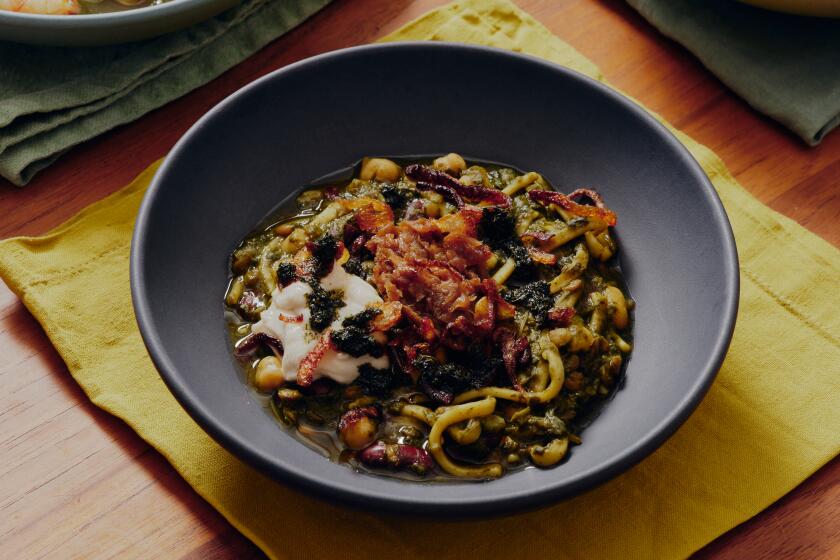Stuffed peach and raspberry sauce

- Share via
In France, chevre simply means goat cheese. In the United States, terms are different. Here is a buyer’s guide.
Chevre: Fresh goat cheese, drained to a soft, spreadable state, then sold loose in pots or rolled into logs. Sold in farmers markets at anywhere from a day to a week old. Perfect for spreading on a bagel or crostini. Supermarket versions will be older and drier. These are fine on bread or crumbled in salad, but they are excellent cooking cheeses that fluff up wonderfully and release the lactic perfume in an omelet or souffle.
Fresh chevre also comes shaped in discs and coated with cracked pepper or herbs.
Chevre from a farmers market should be treated like fruit: Buy small amounts and eat promptly. Always ask for a taste: It should be milky, bright and delicate.
Supermarket logs should be eaten within a week. Check the sell-by date, and beware of watery whey collecting in the plastic packaging. This signifies refrigeration failure or poor draining. Both mean a rank cheese.
Crottin: Made with buttery milk and mold-ripened from six weeks to three months. The inside, called the “pate,” is smooth and glistening white. The rind-ripening will impart a sophisticated, earthy flavor, but the overall taste will be delicate.
The traditional way to serve it is oiled, rolled in bread crumbs, then baked for five to 10 minutes before being set in sharply dressed salads of peppery greens. Judge its ripeness as you would a camembert: It shouldn’t feel rock-hard or completely soft--more like a well-toned stomach.
Goat feta: A fresh Greek-style cheese preserved in brine. The salt leaches the water from the cheese, which is dry and crumbly. Best in salad with plenty of olive oil.
Goat fromage blanc: This cream cheese consists of barely curdled milk that has been only lightly drained and remains unsalted. It is a rare pleasure to find it fresh, when it should taste like an adult version of milk, with the sweetness siphoned off, but a light milky flavor still intact. Perfect for desserts. A slight tang enlivens summer berries.
Marinated goat cheese: Fresh cheeses suspended in olive oil, often infused with rosemary. Perfect for spreading on toast or tossing in salads.
Tome, tomme, shepherd cheeses and Cheddar: Cheeses that have been made with rennet, then drained, dried and aged to become a hard or semihard cheese. Traditionally, a way of preserving summer milk throughout the winter. If the nutty and herbaceous notes are not immediate when the cheese is eaten cold, try melting it on toast and the perfume will rise.
Halve and pit the peaches. Set them in a baking dish. Divide the cheese into 6 portions, roll each into a ball and roll in the cookie crumbs or almonds until well coated. Place a cheese ball into the pit section of each peach half, carefully arranging the peaches so they won’t fall over.
Heat the broiler.
Place the dish 10 to 12 inches beneath the broiler until the peaches are just warmed and the crumbs are becoming crisp, 3 to 4 minutes. Spoon a bit of raspberry sauce onto 6 dessert plates. Place the peaches in the sauce, then dress the peaches with the remaining sauce.
Get our Cooking newsletter.
Your roundup of inspiring recipes and kitchen tricks.
You may occasionally receive promotional content from the Los Angeles Times.















